Many products are obtained by a chemical reaction followed by distillation. Combining these two processes in one would open up new opportunities and create great advantages such as a higher yield, lower equipment costs and reduced energy consumption.
The author: Dr. Daniel Bethge Director Research and Development, GIG Karasek
The combination of a chemical reaction and distillation, i. e. reactive distillation, is already used for esterification reactions as well as for the production of potassium and MTBE (methyl tert-butyl ether). This combination is possible because the process parameters are comparable: one or more products can be removed by evaporation during the reaction process. As a result, the chemical equilibrium is continuously adjusted and shifted in the required direction. In addition to the good yield and nearly complete reaction, the process is very economical. Only a single unit is required instead of a reactor and a distillation column.
A simple distillation boiler, a rectification column or an evaporator are just three of the many possibilities. Almost any kind of distillation unit is suitable depending on the specific requirements. The residence times of the substances in the distillation boiler tend to be very long (comparable to those in an agitator reactor). Shorter, and above all defined, residence times would be a big advantage for temperature-sensitive products or to avoid the formation of high-molecular components.
Rectification columns with special packings are suitable for many applications. A series of separating stages allows products to be removed when they have the required purity. The non-uniform residence times of the individual substances are the column’s main drawback. The situation is totally different in a pipe with ideal flow conditions in which plug flow prevails. Each component there has an identical residence time.
Mixtures as a thin film
The conditions in a thin-film evaporator are similar to those in a pipe. The mixture is applied to the inside of an externally heated cylinder in the form of a thin film and mixed by a special wiper system. The evaporated volatiles are liquefied in an external condenser. High boilers remain in the evaporator. Each high boiler has the same residence time due to the circulation, which causes turbulence in the film. After a dead time, the distribution graph of the typical residence time rises rapidly to a distinct peak and then drops away again. The average residence time decreases owing to the higher flow velocity as the feed rate increases and/or the viscosity decreases. The residence time can be controlled by selecting special wiper elements. The hold-up of product inside the evaporator increases significantly along with the rotation speed, leading to a longer residence time.
The conditions in a falling-film evaporator are very similar in single-pass operation, provided the flow is turbulent. However, the times are much shorter due to the generally lower viscosity and higher liquid load.
Laboratory tested
GIG Karasek achieves optimal operating conditions with the help of laboratory and pilot tests. The thin-film evaporator technology has been proven over a period of several decades and provides the best results. During a condensation reaction, for instance, in which monomers are polymerised as water is sepa-rated, the educts are mixed, heated and continuously fed into the thin-film evaporator. The feed rate and wiping frequency are selected to ensure the necessary residence time for the chemical reaction. A water molecule is released during each reaction between two compounds. Due to the vacuum that is created, the water is continuously removed during the gas phase and subsequently condensed. The amount of distillate is directly proportional to the degree of polymerisation. The vacuum system may have to meet special requirements, depending on the operational conditions.
Hall 4.0, Booth A68
cpp-net.com/0212435
Share:








